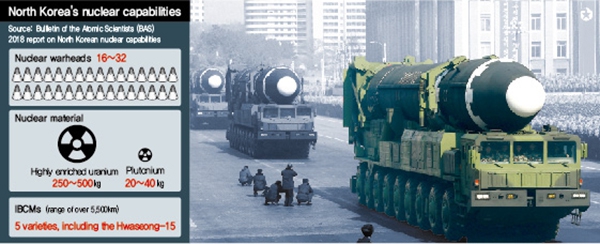 |
|
North Korea‘s nuclear capabilities
|
Bolton says “the quicker they denuclearize,” the quicker North Korea will get what it wants
The approach to North Korea’s denuclearization that White House National Security Advisor John Bolton described in an interview with ABC on May 13 essentially involves complete yet rapid denuclearization and the surrender of nuclear weapons to the US for processing. Bolton explained that PVID (that is, permanent, verifiable, and irreversible denuclearization) means getting rid of all nuclear weapons by disassembling them and shipping their components to Oak Ridge, Tennessee. While Bolton’s proposal for shipping nuclear devices to Oak Ridge is widely regarded in both the domestic and international press as being identical to the Libyan solution that North Korea has rejected, it is actually different. While the nuclear facility at Oak Ridge did process 16kg of highly enriched uranium and centrifuges during the process of downgrading Libya’s nuclear capability between 2003 and 2006, it is also the place that disassembled nuclear weapons when Ukraine, Belarus and Kazakhstan dismantled their nuclear programs after the fall of the Soviet Union in the early 1990s. The problem is not the idea of relocating North Korea’s nuclear weapon components to Oak Ridge per se. Pyongyang’s responses during the “complete denuclearization” process could vary depending on the timeline and sequence for nuclear weapon relocation and abandonment and corresponding measures from Washington. In an interview, Bolton said, “The quicker they denuclearize, the quicker [what they want] will come,” calling the situation a matter of strategic determination by North Korea. A high-ranking foreign affairs and national security source familiar with the North Korea-US negotiation process explained, “What Bolton is arguing comes across as the US saying that before any inspections or verification of North Korea’s nuclear facilities and materials, it wants to first dismantle and abandon the North Korean nuclear warheads and ICBMs that it has viewed as a key security threat.” “Bolton is basically the first one to overtly suggest the kind of ‘big deal’ or ‘big bang’ approach the US has been talking about in its behind-the-scenes negotiations with North Korea,” the source suggested. US argues for reversal of normal denuclearization process This would mean he is arguing for something in the reverse order from the typical denuclearization process, which starts from a freeze to reporting, inspections and verification, and final abandonment of nuclear weapons. It’s also a long way from North Korea’s traditional approach. In a government spokesperson’s statement on July 6, 2016, North Korea said the “denuclearization that we are calling for encompasses denuclearization of the entire Korean Peninsula, the abandonment of South Korean nuclear capabilities and denuclearization around South Korea.” More crucially, it is quite different from the solution described by North Korean leader Kim Jong-un since preparations for the North Korea-US summit entered full swing. In his May 7–8 meeting in Dalian with Chinese President Xi Jinping, Kim declared that North Korea would “have no need to possess nuclear [capabilities] if the hostile policies and security threat against us are eliminated.” He also outlined a methodology that included building mutual trust through North Korea-US dialogue, implementing step-by-step and simultaneous measures, and pursuing a full-scale political resolution process. In his Panmunjeom Declaration with South Korean President Moon Jae-in following their Apr. 27 summit, Kim pledged “complete denuclearization” and a “nuclear-free Korean Peninsula,” but listed these as part of a subcategory (item 4) under Article 3 about ending the armistice regime and establishing a robust peace regime on the Korean Peninsula. Pyongyang wants prosperity in exchange for denuclearization The approach is a comprehensive and reciprocal one. In its July 2016 government spokesperson’s statement, Pyongyang condenses its demands into a list of five: ① disclosing US nuclear weapons present in South Korea, ② withdrawing and verifying US nuclear weapons and bases in South Korea, ③ barring deployment of US strategic nuclear assets on and around the Korean Peninsula, ④ pledging not to use nuclear weapons against North Korea, and ⑤ “declaring” the withdrawal of US troops. These were later adapted and developed into the demands reportedly stated by the North during recent preliminary meetings with the US, namely withdrawing US strategic nuclear assets from South Korea, halting the deployment of strategic nuclear assets during South Korea-US joint exercises, guaranteeing no attacks with conventional or nuclear weapons, replacing the armistice agreement with a peace agreement, and establishing diplomatic relations between North Korea and the US. Despite the surface differences, experts said there was no reason to be too pessimistic, given the nearly one month of negotiating time left before the North Korea-US summit. “North Korea and the US have reached something of a consensus on the ultimate goals of ‘denuclearization’ and ‘[peace and] prosperity,’” said Korea Institute for National Unification director Kim Yeon-cheol. “The problem is the method of exchange, with each side mixing and matching what they want,” Kim added. A former senior government official concluded, “If it wants fast and complete denuclearization of North Korea, the US is going to have to make some corresponding strategic decision to produce any results.” Along similar lines, former Minister of Unification Lee Jong-seok offered optimistic predictions. “Kim Jong-un wants to speed things up just like the [US President]. There’s a chance he could disclose the number of nuclear weapons or facilities and/or a list of ICBMs during or just after the [North Korea-US summit] in order to make swift progress with denuclearization,” Lee suggested. By Lee Je-hun, editor in chief Please direct comments or questions to [english@hani.co.kr]





